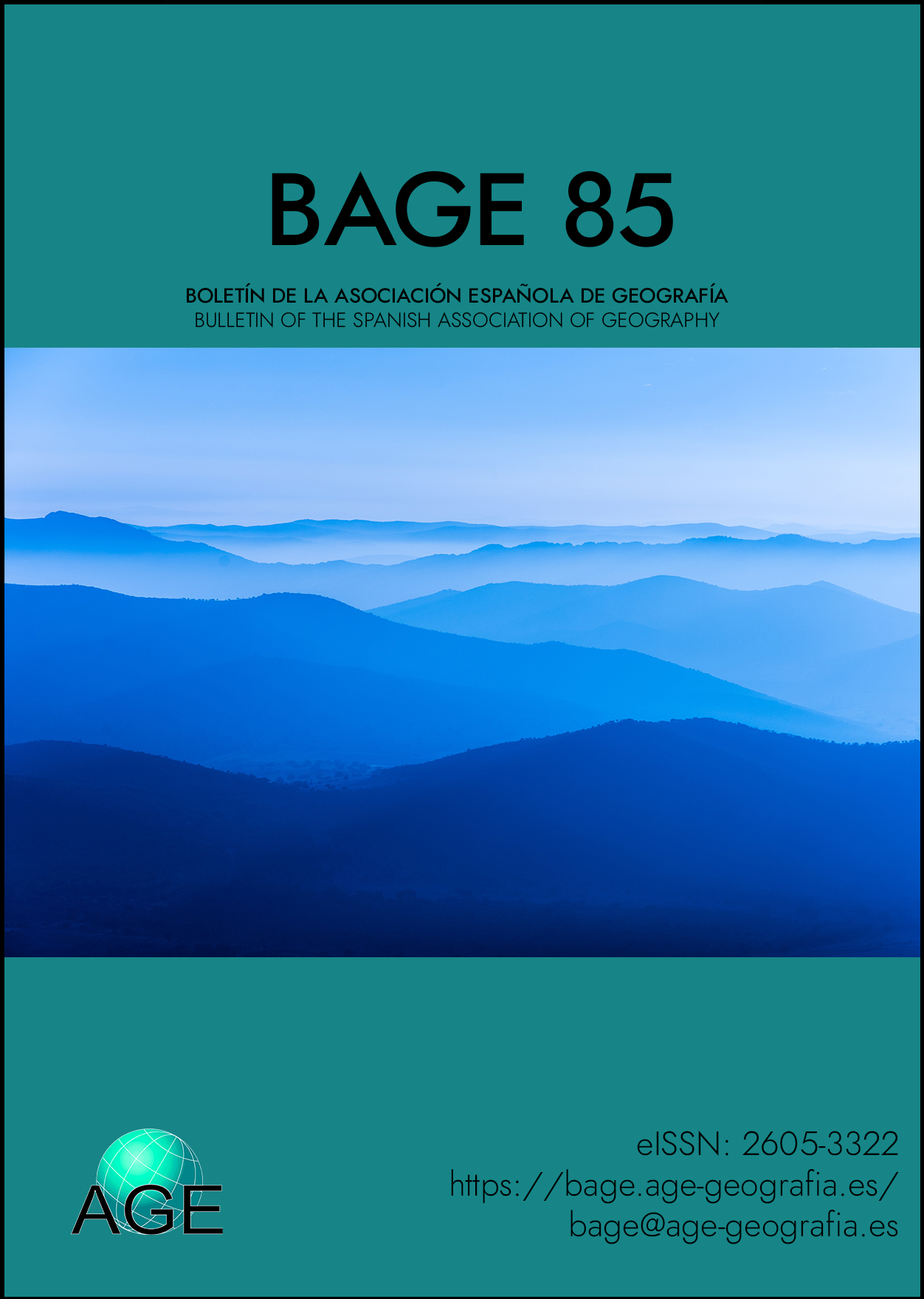Perception of the urban space of Tangier in the Spanish novels of the 21st century
Main Article Content
Abstract
The article presents an analysis of the perception of Tangier's urban space that contemporary Spanish literature projects in the first two decades of the 21st century. The North African city, in the last 20 years, exerts a strong attraction as a stage for novels for various reasons, including its geostrategic condition (border, port, crossroads), its history (especially, time of the International Statute), its economic-commercial values (Free Zones, Port Tangier-Med) and socio-cultural conditions (door of African immigration, coexistence of cultures). The study whose method lies in the detection and priority of the geographical elements perceived in the urban space in the Spanish novels of the 21st century has led to the elaboration of perception maps: of points (nodes and milestones), of lines (paths) and of areas (neighborhoods and borders). The literary perception of the urban scene describes a reality associated with characteristic and emblematic elements.
Downloads
Article Details
References
Araque Jiménez, E. (2015) Orígenes y desarrollo del turismo en el protectorado español del norte de Marruecos (1912-1956). Cuadernos de Turismo, 36, 55–77. http://dx.doi.org/10.6018/turismo.36.230881
Artacho, F. (2018). El correo de Tánger. Sevilla: Algaida.
Barce, S. (2019). Malabata. Málaga: Genal.
Benito Arranz, J., & Vega Benayas, S. (2000). La percepción geográfica de El Cairo de la Trilogía de Naguib Mahfuz. Philologia hispalensis, 14(2), 93–104. Universidad de Sevilla. Retrieved from http://institucional.us.es/revistas/philologia/14_2/art_10.pdf
Boira Maiques, J. V. (2012). Literatura y geografía se dan la mano. A propósito de la novela El mapa y el territorio. Biblio 3W, XVII(995). Retrieved from http://www.ub.es/geocrit/b3w-995.htm.
Bravo Nieto, A. (2000). Arquitectura y Urbanismo Español en el Norte de Marruecos. Sevilla: Consejería de Obras Públicas y Transportes. Junta de Andalucía. Retrieved from http://e-spacio.uned.es/fez/view/bibliuned:UNEDCentroAsociadoMelilla-Libros-7005
Catalá Marticella, R. (2017). La geografía com a narració descriptiva i com construcció d´una “pedagogía del món”. La literatura paisajística de Josep Pla com a cas d´estudi” (Doctoral dissertation, Universitat de Barcelona, Spain). Retrieved from https://www.tesisenred.net/handle/10803/562674#page=1
Ceballos, L. (2006). Historia de Tánger. Córdoba: Almuzara.
Cerarols Ramírez, R. (2009). Paisaje y memoria. Recreaciones literarias de la geografía bélica colonial en Marruecos. Boletín de la Asociación de Geógrafos Españoles, 51, 219–248. Retrieved from https://www.age-geografia.es/ojs/index.php/bage/article/view/1139/1062
Cerarols Ramírez, R. (2015). Geografías de lo exótico: El imaginario de Marruecos en la literatura de viajes (1859–1936). Barcelona: Ediciones bellaterra.
Debarbieux, B. (2015). L’espàce de l’imaginaire. Essais et détours. Paris: Éditions du Centre National de la Recherche Scientifique (CRNS).
Desbois, H. (2002). Réflexions à partir de l´experience du séminaire “Territories littéraires”. In J. Bessièrre, Savoirs et littérature : Literature, the humanities and the social sciences (pp. 65–74). Paris: Presses Sorbonne Nouvelle.
Dueñas, M. (2009). El tiempo entre costuras. Madrid: Temas de Hoy.
González Hidalgo, J. L. (1993). Tánger en la literatura española. Madrid: Instituto de Cooperación con el Mundo Árabe.
Goñi Pérez, J.M. (2009). Los mundos imaginarios postcoloniales. Aljamía, 20, 41–49.
Lévy, B. (2006). Geografía y literatura. In D. Hiernaux & A. Lindon (Dirs.), Tratado de Geografía Humana (pp. 460–480). Barcelona: Anthropos, UAM.
López Barrios, C. (2017). Niebla en Tánger. Madrid: Planeta.
López Lara, E. (2005). Imagen turística de Marruecos en Internet. Reinterpretando el Orientalismo. Cuadernos de Turismo, 16, 123–134. Retrieved from https://revistas.um.es/turismo/article/view/18371
López Lara, E. (2008). El espacio fronterizo del norte de Marruecos: alternativas de cooperación y desarrollo. Estudios Fronterizos, 17, 43–71. Retrieved from http://www.scielo.org.mx/scielo.php?script=sci_arttext&pid=S0187-69612008000100002
López Sánchez, J.A., & Arcila, M. (2014). Análisis de la percepción turística en la Región Tánger-Tetuán (Marruecos). Cuadernos de Turismo, 33, 173–198. Retrieved from https://revistas.um.es/turismo/article/view/195701
Lozano, A. (2002). Harraga. Granada: Zoela.
Lozano, A. (2015). Un largo sueño en Tánger. Córdoba: Almuzara.
Lynch, K. (1960). The image of the city. The Massachussets Institute of Tecnology. Cambridge.
Martín Corrales, E. (2002)- La imagen del magrebí en España. Una perspectiva histórica siglos XVI-–X. Barcelona: Ed. Bellaterra.
Martínez, I. (2015). La ciudad de la mentira. Colección Ánfora & Delfín. Ed. Destino.
Moga Romero, V. (2016). El duelo del pied-noir: una reflexión acerca de la representación del Protectorado en la novela española actual. In El Protectorado español en Marruecos: La Historia trascendida (pp. 247–279). Ed. Iberdrola. Retrieved from http://doczz.es/doc/336456/descargar-pdf---la-historia-trascendida
Moretti, E. (2000). Atlas du roman européen (1800–1900). Paris: Editions du Seuil.
Navarro Palazón, J., & Jiménez Castillo, P. (2007). Algunas reflexiones sobre el urbanismo islámico. Revista Artigrama, 22, 259–298. Retrieved from https://www.unizar.es/artigrama/pdf/22/2monografico/09.pdf
Pack, S. (2015). Turismo, urbanismo y colonialismo en Tánger, 1880–1939. Cuadernos de Historia Contemporánea, 37, 45–65. https://doi.org/10.5209/rev_CHCO.2015.v37.50986
Pérez Reverte, A. (2017) Eva. Ed. Planeta.
Pocock, D.C.D. (1988). Geography and literature. Progress in Human Geography, 12(1), 82–102.
Rojas-Marcos, R. (2018). Tánger, Segunda Patria. Una ciudad imprescindible en la historia y la literatura española. Córdoba: Almuzara.
Said, E. W. (1990). Orientalismo. Córdoba: Ed. Libertarias/Prodhufi, S.A.
Sagnes-Alem, N. (2007). Le mythe de Tanger et Ángel Vázquez. Figures de la mythification dans l’Espagne du XXe siècle. Montpellier: Presses universitaires de la Méditerranée. Retrieved from https://books.openedition.org/pulm/632?lang=es
Serna (de la), A. (2006). Al sur de Tarifa. Madrid: Marcial Pons.
Suárez Japón, J.M. (2002). Geografía y literatura en los escritos de viaje de José Manuel Caballero Bonald. Boletín de la Asociación de Geógrafos Españoles, 34, 133–146. Retrieved from https://bage.age-geografia.es/ojs/index.php/bage/article/view/432
Tuan, Yi-Fu (1978). Literature and geography: implications for geographical research. In D. Ley & M. Samuels (Eds), Humanistic Geography: Prospects and Problems. London: Croom Helm, 194–206.
Valenzuela, J. (2015). Tangerina. Barcelona: Martínez Roca.
Valenzuela, J. (2016). Limones negros. Sevilla: Anantes.
Valle Buenestado, B. (2015). Geografías literarias, paisajes sin cartografías. In Análisis espacial y representación geográfica: innovación y aplicación (pp. 1261–1270). Universidad de Zaragoza y Asociación Geógrafos de España. Retrieved from http://congresoage.unizar.es/eBook/trabajos/132_Valle%20Buenestado.pdf
VV.AA. (2016). El Protectorado español en Marruecos: La Historia trascendida. Madrid: Iberdrola. Retrieved from http://doczz.es/doc/336456/descargar-pdf---la-historia-trascendida

